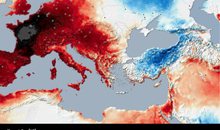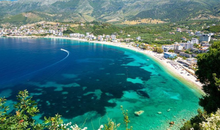
 Flash News
Flash News
Rama targets Shkodra prosecutor again: Gjeli wrote philosophical essay with innocence of illegal construction
Wanted for theft, 26-year-old arrested in Durrës
Released on bail, Salianji appears before the Probation Service
Threatened with a report by Rama, Shkodra prosecutor writes to KLP: React to political attacks
Korça/ 40-year-old man jumps from fifth floor balcony, in critical condition
How will the El Nino phenomenon affect the weather around the world?

Countries around the world are bracing for extreme weather later in the year as the world faces El Niño - the climate phenomenon that triggers tropical cyclones in the Pacific, as well as torrential rains and the risk of flooding, in the Americas and regions others.
On Thursday, the US Oceanic and Atmospheric Administration declared that El Nino is coming.
In the last three years, this phenomenon has been dominated by another phenomenon, La Nina. Scientists believe that this year is worrying.
The last time El Nino was in full force was 2016, when the world recorded its hottest year ever. Meteorologists expect that this year's El Nino, mixed with climate change, will face the world with even higher temperatures.
Experts are also worried about what could happen to the oceans. The extent of El Nino means that waters in the eastern Pacific are warmer than usual.
However, even before El Nino started, in May, the average sea temperature was 0.1 percent higher. This phenomenon can make climate conditions even more extreme.
"We are in unprecedented territory," said Michelle L'Heureux, a meteorologist at the Center for Climate Prediction.
This year, El Nino could result in losses of $3 trillion globally, according to a study published last month in the scientific journal Science, as extreme weather affects agricultural production, the production of other goods and helps spread disease. .
Governments in vulnerable states are taking notes.
Peru has set aside $1.06 billion to deal with damage caused by El Nino, while the cyclone-prone Philippines has set up a special government to deal with what might happen.
El Nino is a natural climate phenomenon that warms the waters to abnormal temperatures in the eastern Pacific. It is created when the winds that blow in the east-west direction, decrease the intensity, or take the opposite direction, changing the air pressure.
Megjithatë, shkencëtarët nuk janë 100 për qind të bindur që këto kushte rezultojnë me një fenomen të tillë. Në periudhën 2015-2016 – kur është regjistruar El Nino-ja më e fuqishme në histori – gjallesat dhe bimët nënujore e kanë pësuar keq.
Ujërat e ngrohta në lindje të Paqësorit barten më pas të atmosferë, duke nxitur stuhi. Në kohën e aktivitetit të El Ninos, jugu i Shteteve të Bashkuara përjeton mot të ftohtë dhe të lagësht, derisa pjesë tjera në perëndim të SHBA-së dhe Kanadasë, janë më të nxehta dhe më të thata.
Aktiviteti i uraganeve bëhet më i lëkundshëm, pasi stuhitë nuk arrijnë të formohen në Atlantik, për shkak të ndryshimit të drejtimit të erës. Mirëpo, ciklonet tropikale forcohen.
Some parts of the central and southern Americas face torrential rainfall, although the Amazon region usually suffers from dry climatic conditions.
Australia, on the other hand, faces extreme heat, drought and forest fires.
Although climate change becomes more visible when El Nino occurs - with high temperatures, or torrential rains - it is not yet known exactly whether climate change affects the phenomenon itself. Scientists are not sure if climate change will change the balance between El Nino and La Nina, to make either of them more frequent or less frequent./ REL
Latest news


Government irony: Rama strips Dredha of power, then demands law and order
2025-07-11 10:49:10
German media: Vlora Airport 'kills' one of Europe's largest wetlands!
2025-07-11 10:37:46

Amid the Alps in Theth, the law punishes even those who try to respect it
2025-07-11 10:14:16
Wanted for theft, 26-year-old arrested in Durrës
2025-07-11 10:03:29
After the dismissals, Rama gathers the mayors in Durrës
2025-07-11 09:42:29
Released on bail, Salianji appears before the Probation Service
2025-07-11 09:34:28

Haxhi Qamil Rama and the directors of the Municipalities!
2025-07-11 09:21:35
30 years since the Srebrenica massacre in Bosnia and Herzegovina
2025-07-11 09:10:52

From rhetoric to brandy, POLITICO: 9 things Nigel Farage can do in Albania
2025-07-11 08:53:35
Trump announces 35% tariffs on Canadian goods
2025-07-11 08:39:29
Foreign exchange, how much foreign currencies are sold and bought today
2025-07-11 08:24:25

Horoscope, what do the stars have in store for you today?
2025-07-11 07:59:39
Sun and high temperatures, weather forecast
2025-07-11 07:41:09
Morning Post/ In 2 lines: What mattered yesterday in Albania
2025-07-11 07:20:14
Zhupa: In Theth, some Austrian strategic investors want the empty area
2025-07-10 22:57:08
Malltezi: SPAK admits, we are in a process that began with Balla's false report
2025-07-10 22:34:16

Si të çliroheni nga bllokimet emocionale me anë të ushtrimeve
2025-07-10 21:57:24

Lala: Veliaj wanted to return as mayor
2025-07-10 21:40:46

VIDEO/ Brawl in Bolivian parliament, deputies physically clash
2025-07-10 21:20:30


Albania experienced one of the longest heat waves of the last decade
2025-07-10 21:01:09

The Government approves new procedures for declaring residence in e-Albania
2025-07-10 20:39:32

Koka: Northerners will not forget Edi Rama's racist operation in Theth
2025-07-10 20:18:24
The 3 zodiac signs that will be most affected by the 'Full Moon' of July 10
2025-07-10 20:04:49
New director of the National Center of Cinematography appointed
2025-07-10 19:51:12
Korça/ 40-year-old man jumps from fifth floor balcony, in critical condition
2025-07-10 19:40:19
'Tired Woman'/ The Syndrome That Affects Thousands of Women Every Day
2025-07-10 19:34:02
Jane Birkin's original Hermès bag sells for $10 million
2025-07-10 19:26:22

Britain-Ukraine agreement signed for 5,000 Thales missiles
2025-07-10 19:00:25
Fire in Zvërnec, flames endanger two hotels
2025-07-10 18:57:19
Croatia restores compulsory military service
2025-07-10 18:39:01
Spahia: The great truth of the strong accusation of the residents of Theth
2025-07-10 18:35:07


The Supreme Court left him in prison, Meta addresses the 'Constitution'
2025-07-10 17:57:21
New punishment with 'new' regulations
2025-07-10 17:54:46
EU translator fired over fears for Zelenskyy's safety
2025-07-10 17:45:37
'You are a policeman, but not God, take my soul', protest for Agon Zejnullahu
2025-07-10 17:41:21


Video/ Rama repeats the scenario, kneels before Meloni again
2025-07-10 16:56:31
He set fire to a plot of olive trees, 50-year-old man arrested in Shijak
2025-07-10 16:46:19

Rubio: US and Russia have exchanged new ideas for Ukraine peace talks
2025-07-10 16:36:20
Death of 27-year-old, Lipjan Police Commander Resigns
2025-07-10 16:21:28
Video/ An apartment burns in Tirana near the New Bazaar
2025-07-10 16:09:36


Jensila lights up the internet with her birthday greetings to Ledri
2025-07-10 15:42:08
They're full of pesticides! List of 12 products we need to be careful of
2025-07-10 15:31:04

Worker falls from scaffolding in Shëngjin, urgently sent to Trauma
2025-07-10 15:11:03
Malltezi: Within one day they seized my accounts, properties and shares
2025-07-10 15:01:23
EU: Israel has agreed to more aid to Gaza
2025-07-10 14:55:19


Murder of Reni Dobra, 23-year-old's vehicle pulled from the water
2025-07-10 14:29:23
Trump's tariffs on Brazil raise coffee prices
2025-07-10 14:16:07
Ursula von der Leyen survives no-confidence vote
2025-07-10 14:04:27


Fire in Lezha, flames near electrical substation
2025-07-10 13:32:24
Residents clash with police in Theth, a woman faints
2025-07-10 13:24:38
"Rama and Xanun"
2025-07-10 13:15:46

Zodiac signs most likely to get divorced in July 2025
2025-07-10 12:45:51
A scapegoat for an illegitimate Republic
2025-07-10 12:35:02
"He has devastated his own nation"/ Berisha: Rama imprisons his opponents!
2025-07-10 12:26:54

Albanian man injured with knife in Italy
2025-07-10 12:08:55






23-year-old in Mat drowned with rope, 4 suspects are being held
2025-07-10 10:58:53

After the dismissals, the new director of the Shkodra Police is appointed
2025-07-10 10:30:10
BIRN: Rama's action for public spaces, a repeated spectacle
2025-07-10 10:29:11
Action in Theth, Shkodra Police leaders dismissed
2025-07-10 10:16:28
Fatal accident on the Tirana-Durres highway
2025-07-10 10:01:58
The incinerator does not exist, but the government continues to increase funds
2025-07-10 09:51:45
Albania is aging at a rapid pace! 30% of the population is over 60 years old
2025-07-10 09:46:23
End of an era, Modric says 'goodbye' to Real Madrid
2025-07-10 09:36:09
Mount Dukat has been on fire for 6 days, residents request air intervention
2025-07-10 09:27:24

